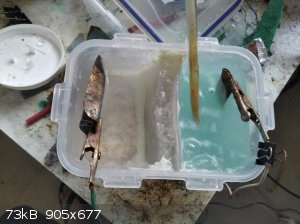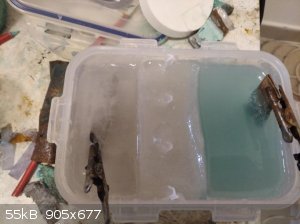hedgehog
Harmless

Posts: 7
Registered: 27-1-2020
Member Is Offline
|
|
CHP from KClO4?
My first post here. Happy to be online with you all. Would it be possible to use KClO4 vs the ammonium to make CHP? Just use a stoichiometric
amount. Possibly dissolve in sodium hydroxide solution first? Please let me know what you think. Thanks.
|
|
|
Tsjerk
International Hazard
    
Posts: 3032
Registered: 20-4-2005
Location: Netherlands
Member Is Offline
Mood: Mood
|
|
Welcome to the forum!
When you have a question, you usually get a lot more replies when you explain a bit about what you already know and what research you did.
And in this case: what is CHP?
|
|
|
hedgehog
Harmless

Posts: 7
Registered: 27-1-2020
Member Is Offline
|
|
Copper Hexamine Perchlorate as synth'd by Dr. Liptakov. All the methods I see use ammonium perchlorate but I have a bunch of potassium perchlorate so
was wondering if it would work. I know you can make NH4ClO4 from KClO4 (or just order it). Just didn't know if the perchlorate from potassium would
attach to the copper triamine complex in the same way and save a step. Thanks for the help! Here's a link to the CHP video if you need it. I'm
trying to use the second method shown.
https://www.bitchute.com/video/Llot8MProETk/
|
|
|
symboom
International Hazard
    
Posts: 1143
Registered: 11-11-2010
Location: Wrongplanet
Member Is Offline
Mood: Doing science while it is still legal since 2010
|
|
It won't work because potassium perchlorate is insoluble
It would have to be converted to perchloric acid then add ammonium hydroxide to the solution to form ammonium perchlorate that's the only method that
could work starting with potassium perchlorate
|
|
|
mackolol
Hazard to Others
  
Posts: 459
Registered: 26-10-2017
Member Is Offline
Mood: Funky
|
|
It is soluble, but poorly, you can heat it up if it doesn't make the reaction dangerous.
Solubility in water:
0.76 g/100 mL (0 °C)
1.5 g/100 mL (25 °C)
4.76 g/100 mL (40 °C)
21.08 g/100 mL (100 °C)
|
|
|
hedgehog
Harmless

Posts: 7
Registered: 27-1-2020
Member Is Offline
|
|
I think potassium perchlorate is soluble in ammonia though, which is what the process uses. See attached patent for producing ammonium perchlorate
from potassium which involves anhydrous ammonia but I'm sure a 30% solution would work with heat. I'm gonna try a one pot synth starting from copper
sulfate. Dissolve the copper sulfate in ammonia hydroxide 30% to produce copper hydroxide in situ. Heat to produce Schweizer's reagent. Add KClO4
slowly until it all dissolves. Add the hexamine in the same manner. Reflux for a while. Cool slowly and filter off any by-products that appear
right way. Grow CHP crystals in the freezer. Any thoughts anyone? Attached is the patent paper.
Attachment: Ammonium Perchlorate from KClO4.pdf (353kB)
This file has been downloaded 541 times
|
|
|
MineMan
International Hazard
    
Posts: 1004
Registered: 29-3-2015
Member Is Offline
Mood: No Mood
|
|
Hedgehog, if you can do this, it would be very helpful. Share the news please!
|
|
|
hedgehog
Harmless

Posts: 7
Registered: 27-1-2020
Member Is Offline
|
|
Well I tried the copper sulfate method and ended up with a small amount of precipitate that looked ok. However, no energetic properties whatsoever.
No crystals formed in the fridge after a few days so I forced a separation by adding acetone. I was happy when I got some very fine dark blue powder
but it won't even burn. Must be too contaminated with sulfates? Anyway, the KClO4 did dissolve in 30% ammonia. I checked this before I started.
I'm sure the copper sulfate is the culprit. I think I'm gonna order some good AP and CuO and do it the right way according to LL. Possibly I should
have used alcohol instead of acetone to separate but I don't think it would have mattered. Any thoughts?
|
|
|
underground
National Hazard
   
Posts: 702
Registered: 10-10-2013
Location: Europe
Member Is Offline
|
|
You can make NaCLO4 or NH3CLO4 from KCLO4 with tartaric acid. Potassium tartrate is insoluble in water while Na and NH3 salts are soluble.
[Edited on 13-5-2020 by underground]
|
|
|
hedgehog
Harmless

Posts: 7
Registered: 27-1-2020
Member Is Offline
|
|
Thank's underground. Never heard of that. Could you elaborate on the synth? Would you dissolve the KClO4 in ammonia and then add tartaric acid to
precipitate out potassium tartrate. Then dry the solvate to get NH3ClO4?
|
|
|
underground
National Hazard
   
Posts: 702
Registered: 10-10-2013
Location: Europe
Member Is Offline
|
|
KCLO4 is soluble in water, not too much but still enough for metathesis reaction.
For the ammonium salt, react tartaric acid with ammonia or ammonium carbonate to form ammonium tartate. Dissolve 1 mol of KCLO4 in hot water and pour
it into a beaker. Then dissolve 1 mole of ammonium tartate in hot water and pour it into another beaker. Make those 2 solutions as much saturated as
possible. When everything dissolved, mix the 2 liquids together. K tartate will ppt out leaving ammonium perchlorate dissolved into water. Filter and
toss the K tartate. Evaporate the water to obtain ammonium perchlorate. The same can be done for Naclo4 but use Na tartate instead of NH3 tartate.
|
|
|
monolithic
Hazard to Others
  
Posts: 436
Registered: 5-3-2018
Member Is Offline
Mood: No Mood
|
|
Does anyone have the primary reference for CHP synthesis? Maybe I'm not looking in the right place but I saw Liptakov reference an Indian paper a few
times but they never actually synthesized or characterized CHP, just other metal derivatives.
|
|
|
Boffis
International Hazard
    
Posts: 1867
Registered: 1-5-2011
Member Is Offline
Mood: No Mood
|
|
@underground; you are getting confused! Potassium tartarate is easily soluble in water, potassium hydrogen tartarate is very sparingly soluble in cold
water. The problem is that the ammonium salts mimic the potassium salts, ammonium hydrogen tartarate is sparingly soluble too. It just might be
possible to do this with say sodium hydrogen tartarate which is freely soluble.
|
|
|
mysteriusbhoice
Hazard to Others
  
Posts: 477
Registered: 27-1-2016
Member Is Offline
Mood: Became chemistry catboy Vtuber Nyaa
|
|
Yes bro it can be done!!
I use an Ion exchange membrane made from agar + NaCl or any salt and even with KClO4 relatively low solubility 1.5g @ 25 Celsius, it will work with
copper anode to make pure copper 2 perchlorate since copper 2 perchlorate is highly soluble in water it will slowly dissolve the KClO4 at the bottom.
you can then pass ammonia gass through that mixture to get TACP.
This is my 1st prototype membrane and subsequent ones will have some supporting structure out of barbecue sticks which will hold since the center of
the gel remains neutral.
edit:
IMPORTANT never use bovine or animal gelatine it will just dissolve in water.
Only use vegetable gelatin or agar for your membranes as they only absorb water which is what you want and be sure to keep the lid on when not using
or the membrane will shrievel up.
Other water absorbing polymers will be explored like sodium polyacrylate but that may get attacked so I have to test but I can confirm that agar
doesnt seem to get attacked and the cell has high current running through it compared to porous pot just keep temp low or it will dissolve.

[Edited on 24-7-2020 by mysteriusbhoice]

|
|
|
hedgehog
Harmless

Posts: 7
Registered: 27-1-2020
Member Is Offline
|
|
mysteriusbhoice--very impressive. I also watched your video on the other thread. I copied the link and attached it to this thread also. I have no
experience in electrolysis but I definitely appreciate your method. I had given up on trying my methods using copper sulfate and/or KCLO4 due to too
much wasted chemicals. I did get a pretty good yield from Dr Lipatov's method and made some CHP and pressed into caps. Haven't tried them yet on any
base charges but they seem pretty powerful by themselves. This is very interesting though. Thanks for sharing.
https://youtu.be/zKJAkKXCFVw
|
|
|
mysteriusbhoice
Hazard to Others
  
Posts: 477
Registered: 27-1-2016
Member Is Offline
Mood: Became chemistry catboy Vtuber Nyaa
|
|
Quote: Originally posted by hedgehog  |
mysteriusbhoice--very impressive. I also watched your video on the other thread. I copied the link and attached it to this thread also. I have no
experience in electrolysis but I definitely appreciate your method. I had given up on trying my methods using copper sulfate and/or KCLO4 due to too
much wasted chemicals. I did get a pretty good yield from Dr Lipatov's method and made some CHP and pressed into caps. Haven't tried them yet on any
base charges but they seem pretty powerful by themselves. This is very interesting though. Thanks for sharing.
https://youtu.be/zKJAkKXCFVw
|
I also have an upcomming video on an improved ion exchange membrane though I will only post a new topic on it once its confirmed to work.
its made of a support microfiber mesh with disodium phthalate + PVA primer crosslinked with sodium tetraborate.
the active membrane polymer is sandwhiched between the 2 surfaces to create one membrane which is much thinner and hopefully has higher current and
wont degrade after 3 runs unlike agar.
video link here:
https://www.youtube.com/watch?v=y_QAemE3aX0
[Edited on 29-7-2020 by mysteriusbhoice]
|
|
|